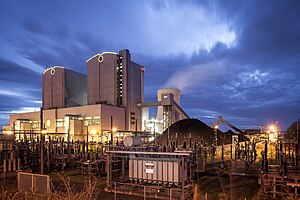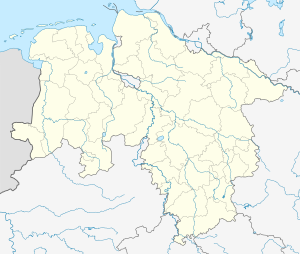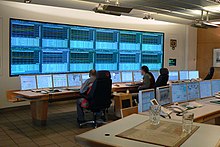Joint power plant in Hanover
| Joint power plant in Hanover | |||
|---|---|---|---|
| Power plant with an upstream substation | |||
| location | |||
|
|
|||
| Coordinates | 52 ° 25 '12 " N , 9 ° 38' 55" E | ||
| country | Germany | ||
| Data | |||
| Type | Thermal power station | ||
| Primary energy | Fossil energy | ||
| fuel | Hard coal | ||
| power | 300 megawatts of electricity 425 megawatts of district heating |
||
| operator |
Stadtwerke Hannover , VW Kraftwerk GmbH |
||
| Project start | 1984 | ||
| Start of operations | 1989 | ||
| Chimney height | 100 m | ||
The Joint Power Plant Hannover (GKH), also known as the Stöcken power plant , is a heating and power plant in the Hanover district of Stöcken . It is operated by Stadtwerke Hannover and VW Kraftwerk GmbH (VWK).
description
The power plant is located at the Nordhafen and near the federal highway 2 . It is located directly between the production facilities of the Volkswagen plant in Hanover (VW Nutzfahrzeuge) and Continental AG. There is a substation on the power plant site .
The joint power plant in Hanover supplies electricity and district heating. The process and space heating requirements of the Volkswagen plant are covered by the combined heat and power plant, as is the base load of district heating and electricity for the supply area of the Stadtwerke Hannover. It is the largest power plant of the Stadtwerke Hannover. The power plant supplies around 50 percent of the city of Hanover's electricity needs.
The power plant is operated with hard coal . More than 90% of the coal is delivered by ship via the Mittelland Canal , the rest by rail. The power plant is equipped with a flue gas desulphurization , flue gas denitrification and a dust separation system.
The joint power plant in Hanover has a striking architecture with its two 80 m high boiler houses and the 80 m high cooling tower. The boiler houses have arched roofs and recessed corners, which should give the compact structures a slim appearance. The stairwells are glazed, and some of the windows have the shape of a porthole . As a result, the building is reminiscent of ship superstructures from many perspectives. The power plant was realized by the architects Bertram + Bünemann from Hanover. The fireplace has a height of 100 m.
The generators generate voltages of 10.5 kilovolts , which are stepped up to the voltage of the 110 kV high-voltage network.
Efficiency and performance
The power plant works on the principle of combined heat and power . The heat extracted from the process is used as district heating for households. At the Volkswagen plant in Hanover, it is also used as process heat . Since the simultaneous production of electricity and district heating increases the utilization of primary energy by a factor of two, the fuel utilization of the power plant reaches a level of up to 88%, the annual mean the degree of fuel utilization is 60%. The fire output of both heating blocks is 750 megawatts . The electrical output at maximum heat extraction is 230 MW, the maximum possible electrical output is 300 MW. The district heating output is a maximum of 425 MW.
history
The origin of the power plant is based on the fact that originally three companies (Stadtwerke, VWK and Continental) had to renew their own power plants due to the stricter environmental protection legislation. A joint heating and power plant was more economical than three individual systems. In 1984 the decision was made to build a new, joint heating and power plant. The project was completed within around three and a half years of construction. In order to guarantee security of supply, a double block system was designed.
In 2008 and 2009, after almost 20 years of operation, major overhauls and overhauls of the power plant were carried out over several weeks, which are due after 80,000 operating hours. The electricity and heat supply of Hanover and the neighboring industrial companies was maintained, as only one of the two blocks was being worked on. On September 20, 2009, the power plant held an open power plant day on the occasion of its 20 years of operation .
Stadtwerke Hannover has been operating its Enercity HolzenergieCenter Hannover here since the end of 2008. Every year around 2,500 tons of firewood are dried on site using district heating from the power plant. Within a few days the wood has an optimal residual moisture of 15 to 20%.
In 2010, Continental AG left the power plant company. The shares were taken over by Stadtwerke Hannover.
The coal is used almost exclusively by ship via the Mittellandkanal delivered
Entrance to the power plant with the two boiler houses
Further power plants of the Stadtwerke Hannover
Web links
- Brochure about the joint power plant in Hanover (PDF; 2.2 MB)
- Interactive 360 ° panorama photo of the power plant and the surrounding area
Individual evidence
- ↑ a b c d Hannover heating plant. VW Kraftwerk GmbH, accessed on July 28, 2011 .
- ↑ a b c d e f g h i j k l m n Technology in the service of the environment. (PDF brochure; 2.2 MB) Hannover power plant. enercity / VW Kraftwerk, accessed on July 28, 2011 .
- ^ A b Hermann Otto (Ed.): New architecture in Hanover ... the 80s. Artforum Verlag, Hannover 1991, pp. 83-88, ISBN 3-928314-01-7 .






